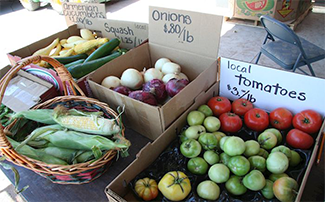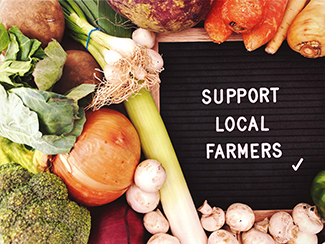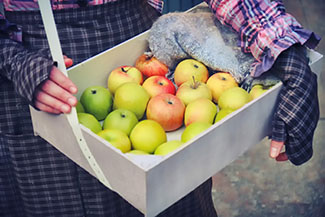Community Supported Agriculture In Arizona
Community Supported Agriculture In Arizona | #BoxedVegetables
We turn to the experts at Arizona Farm Bureau for this week's Outdoor Living Hour topic: #BoxedVegetables. Julie Murphree, Arizona Farm Bureau's Outreach Director clues us in on all things Community Supported Agriculture (CSA) related including the history of and re-awakening of the local food movement:
We Were Local When Local Wasn’t Cool
Much talk about “local” has spurred a multitude of conversations, especially during the pandemic of 2020. But, did you know, 100 years ago nearly every farmer and rancher in Arizona, and America, grew for the local market. The local ag product market has had ebbs and flows, but for long-time farm and ranch families we’ve always embraced the local market.

Just so history isn’t lost on us, if you had a time capsule and could go back in history to visit with the Smallhouse, Rovey, Dobson, Murphree or Sossaman farm families (or any other farm and ranch family in Arizona before statehood), they’d walk you around the farm explaining what crop was going to what market, always having a mix of product for local and regional markets.
They would take you to their garden too or their livestock pens and explain that they were growing and raising for their own family and the neighbors across the way. They might even tell you they had a growing market for their backyard egg farm (think Hickman’s when they first started out in Arizona).
And while local agriculture markets have had ebbs and flows, a resurgence of a broader local Arizona ag market took place in the early 1990s during a time when community supported agriculture (CSAs) in Arizona was really taking off. In conversations with farmer and Arizona Farm Bureau member Frank Martin of Crooked Sky Farms, you’ll hear him describe those early days and how exciting it was to be part of a local movement of locally grown food.
Fast forward to today and the 2020 pandemic and bottlenecks in the food supply chain and you have another re-awakening of the local food movement, especially in the meat markets, certainly beef.
For us in agriculture, it never went away. My dad, the cotton farmer (plus other crops), may have grown for a vast global market but he had roots in local markets with his own family when he was growing up on the farm; it included selling local beef (anyone remember Thomas meat locker in Chandler, I believe Arizona Avenue) and later mom’s garden that over produced to feed an entire small town community, along with other farm families in the area.
So, I’ve changed the title to the Song, “We Were Country When Country Wasn’t Cool” … farmers and ranchers have always been local, even when it wasn’t cool.

That’s why Arizona Farm Bureau has hosted Fill Your Plate for the last 13 years. Launched in 2007, Fill Your Plate is a searchable database designed to connect Arizona families with the local farm and ranch market. Our four separate databases are constantly being updated to provide users with up-to-date information on our local ag markets.
When you source on Fill Your Plate, you get a full gamut of information.
- It’s the most comprehensive list of direct-market, retail farmers and ranchers in the state … I’ll take bets on that one.
- Currently, it’s one of the only Arizona-centric “searchable” lists that’s also mobile friendly. I also give props to Local First Arizona’s Local Food Finder which hosts something along this line; but theirs is not exclusively ag-focused. They list value-added products and businesses too (a good thing and something unique to them).
- In our “beef” search alone, there are more than 50 producers as we’re always on the search for more. Two months ago we only had 30 beef producers. Because of the surge in demand during the COVID19 pandemic for local beef, the count has come close to doubling.
- Fill Your Plate is evergreen and we’re constantly adding new retail farmers to the searchable database.
Ask any farmer or rancher today, whether they’re generational (celebrating 50 to 100 years in business, for example) or a beginner farmer or rancher, we’ll always grow and raise to the market’s needs. Today, you want local beef and wine? We’ve got it for you!
The Robust Support of Today’s Modern Community Supported Agriculture
Arizona’s market value in direct agriculture sales of farm products sold directly to consumers was $3.85 billion in 2017, versus 3.73 billion in 2012, according to the United States Department of Agriculture’s (USDA) most recent information. Data represent the value of edible products, including value-added products, produced, and sold for human consumption directly to consumers at farmers' markets, on-farm stores or farm stands, roadside stands or stores, u-pick, Community Supported Agriculture (CSA), and online marketplaces.
So, while the USDA data from their last two Census of Agriculture can’t provide sales data exclusively on CSAs, we know direct farms sales is a growing market in Arizona. Nationally, the direct agriculture product market is $388 billion.
Established as early as the 1990s in Arizona, CSAs provide consumers access to locally grown food that comes directly from the local farmer. CSAs provide produce and a way for farmers to share the variety of their agriculture with consumers interesting in participating. For retail or direct market farmers that develop a CSA program on their farm, they gain much-needed capital at the beginning of the growing season, and consumers receive fresh, locally grown produce each week. CSAs vary greatly in distribution, cost, consumer involvement at the farm and more.

According to the USDA, “Community Supported Agriculture consists of a community of individuals who pledge support to a farm operation so that the farmland becomes, either legally or spiritually, the community's farm, with the growers and consumers providing mutual support and sharing the risks and benefits of food production.”
In a traditional CSA model:
-
- Members share the risks and benefits of food production with the farmer.
- Members buy a share of the farm’s production before each growing season.
- In return, they receive regular distributions of the farm’s bounty throughout the season.
- The farmer receives advance working capital, gains financial security, earns better crop prices, and benefits from the direct marketing plan.
Benefits to farmers:
- Build a committed customer base.
- To help with cash flow, receive payment early in the season.
- Get to spend time marketing the food early in the year before field season begins.
Benefits to Consumers:
- Creates Convenience.
- Purchased food is usually harvested within hours, or a day or two, of delivery.
- Creates a regular commitment for fresh vegetables and fruit.
- Get exposed to new vegetables and new ways of cooking.
- Many farmers include a weekly recipe as part of the box of vegetables.
- Creates an opportunity to develop a relationship with the farmer who is often a part of the community.
Interesting Facts:
-
- Tens of thousands of families have joined CSAs nationwide.
- Arizona is recognized as an early adopter of the CSA model.
- Data collected in 2015 by the U.S. Department of Agriculture indicates that 7,398 farms in the United States sold products directly to consumers through a community-supported agriculture (CSA) arrangement. CSAs accounted for $226 million (or 7 percent) of the $3 billion in direct-to-consumer sales by farms. While this figure is 6 years old, it’s anticipated the number has grown as connecting with the farmer has become more popular.
- There are many variations of CSAs including “market style,” food bank models, specific commodity shares, (i.e. fruit, bakery, eggs, meat, dairy etc.).
Podcast
The Arizona Farm Bureau's Julie Murphree discusses Community Supported Agriculture (CSA). With the pandemic and food supply chain issues, there's a re-awakening of the local food movement. Getting the freshest produce direct from local farms while helping farmers stay in business. Plus Arizona Farm Bureau President Stephanie Smallhouse talks about the importance of CSA's in smaller communities and the effect record monsoon rain has had on Arizona farming.
###
Photo Credit
- Arizona Farm Bureau
- Shutterstock
